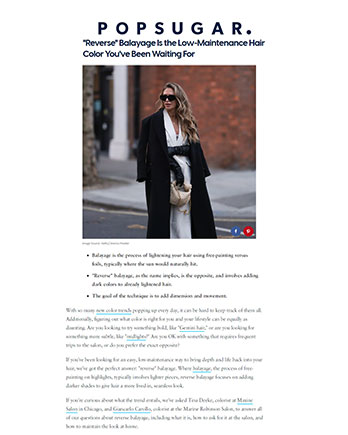Popsugar March 22, 2023
 Popsugar
Popsugar
Beauty
"Reverse" Balayage Is the Low-Maintenance Hair Color You've Been Waiting For
- Balayage is the process of lightening your hair using free-painting versus foils, typically where the sun would naturally hit.
- "Reverse" balayage, as the name implies, is the opposite, and involves adding dark colors to already lightened hair.
- The goal of the technique is to add dimension and movement.
With so many new color trends popping up every day, it can be hard to keep track of them all. Additionally, figuring out what color is right for you and your lifestyle can be equally as daunting. Are you looking to try something bold, like "Gemini hair," or are you looking for something more subtle, like "midlights?" Are you OK with something that requires frequent trips to the salon, or do you prefer the exact opposite?
If you've been looking for an easy, low-maintenance way to bring depth and life back into your hair, we've got the perfect answer: "reverse" balayage. Where balayage, the process of free-painting on highlights, typically involves lighter pieces, reverse balayage focuses on adding darker shades to give hair a more lived-in, seamless look.
If you're curious about what the trend entails, we've asked Tina Deeke, colorist at Maxine Salon in Chicago, and Giancarlo Carollo, colorist at the Marine Robinson Salon, to answer all of our questions about reverse balayage, including what it is, how to ask for it at the salon, and how to maintain the look at home.
What Is Reverse Balayage?
First, a little background on what balayage means. "Balayage" is a French word for "to sweep," and as the name implies, it typically involves hand-painting a color lighter than a person's base shade. Unlike traditional foil highlights, this is used with a paint brush or something similar. The trick behind a good balayage is applying the color where the sun would naturally hit, which gives the most effortless, sun-kissed look. "Balayage gives softer, less noticeable regrowth lines with the principal idea being less is more," Jack Howard, a London-based celebrity colorist, and L'Oréal Professionnel color spokesperson, previously told POPSUGAR.
As for reverse balayage, rather than hand-painting the hair with a lighter color, a darker hue is utilized. The technique is used to soften existing balayage or foil highlights and adds contrast to the hair. "The idea is to blend the client's natural color, or a tone that you and your colorist agree upon, into previously highlighted hair to create a melted, gradient look from root to ends," Carollo tells POPSUGAR.
While the trend is popular among blondes and often used as an easy way to transition to a darker tone, the look also works for brunettes and redheads, and can essentially be customized for any hair color. For blondes, the addition of darker shades will help their lighter pieces pop, and for brunettes with highlights, it gives their hair a more lived-in, natural feel. Plus, a darker root typically means less upkeep.
If you want to ask for reverse balayage, Carollo first recommends booking a consultation appointment. "This is probably the most important part of any color process," he says. Both Deeke and Carollo recommend booking as a full highlight or balayage appointment because the length of the appointment will end up being longer than a single process hair color or root touch-up. And, as always, you should have a clear idea of what you're looking to achieve, with pictures in hand. "Bring inspiration photos along too, that way you can collaborate with your stylist on your new look," Deeke says.
Once you've agreed upon the final look, Carollo says your colorist will typically begin by applying a single process color. "I like to use a tone that is half a shade or one shade lighter than the natural tone," he says. From there, the next step is to apply a demi-permanent color to the roots. Then, another tone which is a shade or two lighter than the root color would be used on the mid-section of the hair. "The reason I would use a lighter tone is to create dimension as a balayage highlight would," Carollo says. Once that step is finished, your colorist will usually leave your hair to process for up to 30 minutes, rinse everything out, shampoo and condition, and then dry and style your hair.
How to Maintain Reverse Balayage at Home
One major plus? Once everything is said and done, the in-salon upkeep is low-key. "I've noticed clients asking for a lower-maintenance color routine, and this is a recession-friendly technique if you're looking to stretch your time between colors," Deeke says. Carollo agrees, adding, "One or two processes is usually all your will need in a six-month time frame, and thereafter you would most likely keep up with balayage highlights every four to six months.
When it comes to keeping your color looking fresh at home, as always, it's important to use a heat protectant any time prior to using hot tools like a blow dryer or curling iron. Our current favorite is the Drybar Hot Toddy Heat Protectant Mist ($29). Deeke suggests using the L'Oréal Metal Detox Mask ($48), which she says helps with color fading and allows highlights to look brighter for longer periods of time.
Deeke and Carollo both suggest always using a color-safe shampoo and conditioner, like the Oribe Hair Alchemy Shampoo ($52) and the Oribe Beautiful Color Conditioner ($52).
